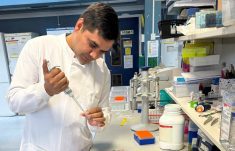There’s no question that precision farming technology works. Yield monitors do monitor yields. GPS does pinpoint your location, and computer programs do combine the two to produce multi-coloured, ultra-accurate yield maps.
For most farmers, however, the question isn’t whether the technology works. It’s whether it pays.
At last, there’s more evidence that it makes economic sense.
There have always been good paybacks with some easy-to-reach, low-hanging fruit, says OMAFRA corn specialist Greg Stewart. As one example, lime application rates can be targeted using soil test pH levels.
Read Also

Producers aren’t panicking over tariffs and trade threats
The influence of tariff and trade uncertainity on farm business decisions.
As well, yield mapping can find those poor-performing areas of your fields so you can identify compaction, poor drainage or other problems. “There’s been a lot of tile drainage put in as a result of yield monitors,” agrees Dale Cowan, senior agronomist with Southern Cooperative Services in southwestern Ontario.
When you see yields drop as much as 100 bushels per acre in a wet spot, you can see that more tile would pay for itself, Cowan explains. “There’s a feedback loop confirming your management… it puts a number on things.”
However, precision farming hasn’t exactly proved the magic bullet that many predicted in the early ’90s when the technology first became available.
“I’m a little frustrated that in the last 15 years we have made as little progress as we have,” says Stewart.
Only a small number of farmers are using precision farming to target fertilizer applications, says Stewart. Brent Cain is one of those farmers.
Cain says he jumped into variable-rate nitrogen application with both feet when he bought a yield monitor six years ago. Management zones were created using yield maps and soil test results. Then certified crop adviser Greg Kitching made prescription maps to vary the rate of 28 per cent nitrogen applied by Cain’s no-till planter.
“I’ve been saving money by applying less N in areas that won’t respond to it,” Cain says. Strip trials confirmed the results.
In 2012 Cain plans to try variable-rate seeding. “The good areas will get more seed, the poor areas less,” he says.
No single approach will work for every farmer though. Steve Twynstra, owner of Twilight Acre Farms in Ailsa Craig, Ont. bought his first yield monitor in 1994. “For the first 10 years we just made a lot of pretty pictures because we didn’t have the agronomic models to use the data,” Twynstra says. “It’s been a lot of trial and error.”
Twynstra has created management zones for N application using normalized yield maps derived from multiple crops over multiple years. He has also factored in variety expectations, fertility history, productive capacity of the land and OMAFRA’s N calculator.
Now Twynstra sums up their results by saying that yes, they are using N more efficiently, but there is still a lot of art involved in variable-rate management.
Kitching agrees that precision farming isn’t a magic wand. “This is a tool to assist with making agronomic decisions,” Kitching says
Others agree. And they also agree that this help shouldn’t be underestimated. Nor should it be undervalued.
Precision technology makes it much simpler to run much better test plots, says Karon Cowan, owner of AgTechGIS in Embro, Ont. Cowan sells precision farming equipment, makes prescription maps and teaches people how to use the software.
Precision ag helps you try options such as variable seeding rates, fertility treatments, and variety trials. Then it lets you measure and assess the results, she says.
In fact, says Dale Cowan, “It allows you to turn your whole farm into a test plot.” As a result, most farmers will see ongoing gains. And while those gains may be small and incremental gains, they can really add up. For example, a reasonable target may be to improve nutrient efficiency by five per cent per year.
To get those gains, having a support person who helps you use the technology and make sense of it all may be as important as the equipment itself. This could be the person who sold you the equipment, a consultant or someone at the co-op.
As far as learning how to use the software, Karon Cowan finds that farmers benefit the most when she works with them one-on-one. “Every farmer is unique and has his or her own needs and interests.”
Precision farming is an ongoing journey, emphasizes Kitching. “Things are going to keep changing and they’re going to be getting more exciting.”
Karon Cowan agrees. If you dabbled in the past but got frustrated with the technology, she urges you to try again. “What was and what is are two different stories. It’s a lot easier to use now and more exciting.” CG















